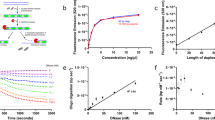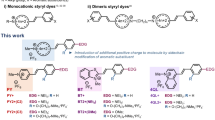Abstract
Enzymatic ligation methods are useful in diagnostic detection of DNA sequences. Here we describe the investigation of nonenzymatic phosphorothioate–iodide DNA autoligation chemistry as a method for detection and identification of both RNA and DNA sequences. Combining ligation specificity with the hybridization specificity of the ligated product is shown to yield discrimination of a point mutation as high as >104-fold. Unlike enzymatic ligations, this reaction is found to be equally efficient on RNA or DNA templates. The reaction is also shown to exhibit a significant level of self-amplification, with the template acting in catalytic fashion to ligate multiple pairs of probes. A strategy for fluorescence labeling of three autoligating energy transfer (ALET) probes and directly competing them for autoligation on a target sequence is described. The method is tested in several formats, including solution phase, gel, and blot assays. The ALET probe design offers direct RNA detection, combining high sequence specificity with an easily detectable color change by fluorescence resonance energy transfer (FRET).
This is a preview of subscription content, access via your institution
Access options
Subscribe to this journal
Receive 12 print issues and online access
$209.00 per year
only $17.42 per issue
Buy this article
- Purchase on Springer Link
- Instant access to full article PDF
Prices may be subject to local taxes which are calculated during checkout




Similar content being viewed by others
References
Whitcombe, D., Newton, C.R. & Little, S. Advances in approaches to DNA-based diagnostics. Curr. Opin. Biotechnol. 9, 602–608 (1998).
Orita, M., Iwahana, H., Kanazawa, H., Hayashi, K. & Sekiya, T. Detection of polymorphisms of human DNA by gel electrophoresis as single-strand conformation polymorphisms. Proc. Natl. Acad. Sci. USA 86, 2766–2770 (1989).
Myers, R.M., Larin, Z. & Maniatis, T. Detection of single base substitutions by ribonuclease cleavage at mismatches in RNA:DNA duplexes. Science 230, 1242–1246 (1985).
Lyamichev, V., Brow, M.A. & Dahlberg, J.E. Structure-specific endonucleolytic cleavage of nucleic acids by eubacterial DNA polymerases. Science 260, 778–783 (1993).
Soto, D. & Sukumar, S. Improved detection of mutations in the p53 gene in human tumors as single-stranded conformation polymorphs and double-stranded heteroduplex DNA. PCR Methods Appl. 2, 96–98 (1992).
Sokolov, B.P. Primer extension technique for the detection of single nucleotide in genomic DNA. Nucleic Acids Res. 18, 3671 (1990).
Alves, A.M. & Carr, F.J. Dot blot detection of point mutations with adjacently hybridising synthetic oligonucleotide probes. Nucleic Acids Res. 16, 8723 (1988).
Whitcombe, D., Theaker, J., Guy, S.P., Brown, T. & Little, S. Detection of PCR products using self-probing amplicons and fluorescence. Nat. Biotechnol. 17, 804–807 (1999).
Ferguson, J.A., Boles, T.C., Adams, C.P. & Walt, D.R. A fiber-optic DNA biosensor microarray for the analysis of gene expression. Nat. Biotechnol. 14, 1681–1684 (1996).
Gunderson, K.L., et al. Mutation detection by ligation to complete n-mer DNA arrays. Genome Res. 8, 1142–1153 (1998).
Guo, Z., Liu, Q. & Smith, L.M. Enhanced discrimination of single nucleotide polymorphisms by artificial mismatch hybridization. Nat. Biotechnol. 15, 331–335 (1997).
Tyagi, S., Bratu, D.P. & Kramer, F.R. Multicolor molecular beacons for allele discrimination. Nat. Biotechnol. 16, 49–53 (1998).
Landegren, U., Samiotaki, M., Nilsson, M., Malmgren, H. & Kwiatkowski, M. Detecting genes with ligases. Methods 9, 84–90 (1996).
Barringer, K.J., Orgel, L., Wahl, G. & Gingeras, T.R. Blunt-end and single-strand ligations by Escherichia coli ligase: influence on an in vitro amplification scheme. Gene 89, 117–122 (1990).
Wu, D.Y. & Wallace, R.B. The ligation amplification reaction (LAR)—amplification of specific DNA sequences using sequential rounds of template-dependent ligation. Genomics 4, 560–569 (1989).
Nickerson, D.A. et al. Automated DNA diagnostics using an ELISA-based oligonucleotide ligation assay. Proc. Natl. Acad. Sci. USA 87, 8923–8927 (1990).
Barany, F. Genetic disease detection and DNA amplification using cloned thermostable ligase. Proc. Natl. Acad. Sci. USA 88, 189–193 (1991).
Landegren, U., Kaiser, R., Sanders, J. & Hood, L. A ligase-mediated gene detection technique. Science 241, 1077–1080 (1988).
Wu, D.Y. & Wallace, R.B. Specificity of the nick-closing activity of bacteriophage T4 DNA ligase. Gene 76, 245–254 (1989).
Samiotaki, M., Kwiatkowski, M., Parik, J. & Landegren, U. Dual-color detection of DNA sequence variants by ligase-mediated analysis. Genomics 20, 238–242 (1994).
Luo, J., Bergstrom, D.E. & Barany, F. Improving the fidelity of Thermus thermophilus DNA ligase. Nucleic Acids Res. 24, 3071–3078 (1996).
Favis, R. et al. Universal DNA array detection of small insertions and deletions in BRCA1 and BRCA2. Nat. Biotechnol. 18, 561–564 (2000).
Nilsson, M., Barbany, G., Antson, D., Gertow, K. & Landegren, U. Enhanced detection and distinction of RNA by enzymatic probe ligation. Nat. Biotechnol. 18, 791–793 (2000).
Pritchard, C.E. & Southern, E.M. Effects of base mismatches on joining of short oligodeoxynucleotides by DNA ligases. Nucleic Acids Res. 25, 3403–3407 (1997).
Sokolova, N.I., Ashirbekova, D.T., Dolinnaya, N.G. & Shabarova, Z.A. Chemical reactions within DNA duplexes. Cyanogen bromide as an effective oligodeoxyribonucleo-tide coupling agent. FEBS Lett. 232, 153–155 (1988).
Ashley, G.W. & Kushlan, D.M. Chemical synthesis of oligodeoxynucleotide dumbbells. Biochemistry 30, 2927–2933 (1991).
Zhan, Z.-Y.J. & Lynn, D.G. Chemical amplification through template-directed synthesis. J. Am. Chem. Soc. 119, 12420–12421 (1997).
Luo, P., Leitzel, J.C., Zhan, Z.-Y.J. & Lynn, D.G. Analysis of the structure and stability of a backbone-modified oligonucleotide: implications for avoiding product inhibition in catalytic template-directed synthesis. J. Am. Chem. Soc. 120, 3019–3031 (1998).
Gryaznov, S.M. & Letsinger, R.L. Chemical ligation of oligonucleotide in the presence and absence of a template. J. Am. Chem. Soc. 115, 3808–3809 (1993).
Gryaznov, S.M., Schultz, R., Chaturved, S.K. & Letsinger, R.L. Enhancement of selectivity in recognition of nucleic acids via chemical autoligation. Nucleic Acids Res. 22, 2366–2369 (1994).
Chladek, S. & Nagyvary, J. Nucleophilic reactions of some nucleoside phosphorothioates. J. Am. Chem. Soc. 94, 2079–2084 (1972).
Herrlein, M.K., Nelson, J.S. & Letsinger, R.L. A covalent lock for self-assembled oligonucleotide conjugates. J. Am. Chem. Soc. 117, 10151–10152 (1995).
Cook, A.F. Nucleoside S-alkyl phosphorothioate. IV. Synthesis of nucleoside phosphorothioate monoesters. J. Am. Chem. Soc. 92, 190–195 (1970).
Xu, Y. & Kool, E.T. A novel 5′-iodonucleoside allows efficient nonenzymatic ligation of single-stranded and duplex DNAs. Tetrahedron Lett. 38, 5595–5598 (1997).
Liu, J. & Taylor, J.-S. Template-directed photoligation of oligodeoxyribonucleotides via 4-thiothymidine. Nucleic Acids Res. 26, 3300–3304 (1998).
Albagli, D., Van Atta, R., Cheng, P., Huan, B. & Wood, M.L. Chemical amplification (CHAMP) by a continuous self-replicating oligonucleotide based system. J. Am. Chem. Soc. 121, 6954–6955 (1999).
Xu, Y. & Kool, E.T. High sequence fidelity in a non-enzymatic DNA autoligation reaction. Nucleic Acids Res. 27, 875–881 (1999).
Reddy, E.P., Reynolds, R.K., Santo, E. & Barbacid, M. A point mutation is responsible for the acquisition of transforming properties by the T24 human bladder carcinoma oncogene. Nature 300, 149–152 (1982).
Luther, A., Brandsch, R. & von Kiedrowski, G. Surface-promoted replication and exponential amplification of DNA analogues. Nature. 19, 245–248 (1998).
Xu, Y. & Kool, E.T. Chemical and enzymatic properties of bridging 5′-S-phosphorothioester linkages in DNA. Nucleic Acids Res. 26, 3159–3164 (1998).
Xu, Y. Molecular recognition and detection of nucleic acid sequences. Ph.D. Thesis, University of Rochester, Rochester, NY (1999).
Stryer, L. Fluorescence energy transfer as a spectroscopic ruler. Annu. Rev. Biochem. 47, 819–846 (1978).
Wu, P. & Brand, L. Resonance energy transfer: methods and applications. Anal. Biochem. 218, 1–13 (1994).
Yang, M. & Millar, D.P. Fluorescence resonance energy transfer as a probe of DNA structure and function. Methods Enzymol. 278, 417–444 (1997).
Cardullo, R.A., Agrawal, S., Flores, C., Zamecnik, P.C. & Wolf, D.E. Detection of nucleic acid hybridization by nonradiative fluorescence resonance energy transfer. Proc. Natl. Acad. Sci. USA 85, 8790–8794 (1988).
Hung, S.C., Mathies, R.A. & Glazer, A.N. Optimization of spectroscopic and electrophoretic properties of energy transfer primers. Anal. Biochem. 252, 78–88 (1997).
Heid, C.A., Stevens, J., Livak, K.J. & Williams, P.M. Real time quantitative PCR. Genome Res. 6, 986–994 (1996).
Acknowledgements
We thank the National Institutes of Health (GM60612) and the Army Research Office for support.
Author information
Authors and Affiliations
Corresponding author
Rights and permissions
About this article
Cite this article
Xu, Y., Karalkar, N. & Kool, E. Nonenzymatic autoligation in direct three-color detection of RNA and DNA point mutations. Nat Biotechnol 19, 148–152 (2001). https://doi.org/10.1038/84414
Received:
Accepted:
Issue Date:
DOI: https://doi.org/10.1038/84414



